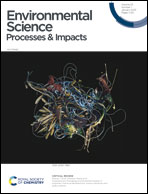Development of a quantitative structure–activity relationship model for predicting quantum yield of hydroxyl radical generation from organic compounds†
Abstract
Organic compounds are capable of generating hydroxyl radicals (˙OH) through their excited triplet states in natural water. It is of significance to reveal the underlying mechanism of the generation and obtain the generation quantum yield of ˙OH from organic compounds for better understanding of its involvement in indirect photochemical processes in the environment. In this study, the ˙OH quantum yields (Φ˙OH) of 20 organic compounds were determined by photochemical experiments. The calculated Φ˙OH values for the selected organic compounds vary from (1.2 ± 0.39) × 10−5 to (7.2 ± 0.16) × 10−4. A quantitative structure–activity relationship (QSAR) model for log Φ˙OH was developed and the established model was proven to have a proper goodness of fit, robustness, and predictive ability. The QSAR model was successfully used to predict the Φ˙OH value of organic pollutants. Mechanistic interpretation showed that the electron distribution and the electronegativity of organic compounds are the most important factors that determine the generation of ˙OH. The results are helpful for understanding the generation mechanism of ˙OH from organic compounds and also provide insights into the generation of ˙OH from dissolved organic matter in natural water.



 Please wait while we load your content...
Please wait while we load your content...